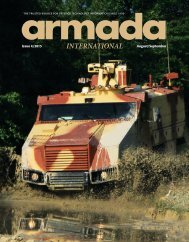Oct 2012 Compendium 1 - Armada
Oct 2012 Compendium 1 - Armada
Oct 2012 Compendium 1 - Armada
You also want an ePaper? Increase the reach of your titles
YUMPU automatically turns print PDFs into web optimized ePapers that Google loves.
NANOcERAMIcS “GlASS” FROM IBd dEISENROTH<br />
At Eurosatory <strong>2012</strong> IBD Deisenroth, the well known German armour solutions<br />
company unveiled a new member of its ceramic products based on nanotechnologies<br />
that might well have a considerable impact on light armoured vehicles protection levels.<br />
The Bonn-based company has been displaying its nanotech-based armour solutions<br />
that halve weights for any given protection level for at least a year. The new family<br />
member, however, makes a genuine breakthrough in the light armoured vehicle<br />
world as it is transparent and thus appears as perfect lightweight replacement for<br />
armoured glass as the author’s picture herewith shows.<br />
The transparent surface is made of a series of tiles of about 50x50 mm made of<br />
synthetic ceramics; the crystal structure is in the low nanorange as a very fine grain<br />
is needed to ensure transparency. The tile size depends very much on the threat<br />
to be countered, a special bonding process being used to joint the tiles together.<br />
Boundaries are invisible, producing a large transparent surface. Those tiles are then<br />
sandwiched with a front glass side to bar abrasion, and a plastic back carrier that<br />
absorbs the residual kinetic energy. The key point here is again weight: the Level 3<br />
transparent ceramic protection shown by IBD Deisenroth boasts a weight of 56 kg/<br />
m2, which is nearly a quarter of the 200 kg/m2 of standard armoured glass rated<br />
at the same protection level. According to potential users sources the price is still<br />
considerably higher than the armoured glass, but industrialisation combined with<br />
the increasing use of transparent nanoceramics should eventually make costs drop<br />
to challenging levels.<br />
protected command and control vehicle<br />
(and which still falls in the light armoured<br />
vehicles category examined here). Some<br />
initial batches of General Dynamics<br />
Eagle IVs were acquired through urgent<br />
operation requirement procedures, but for<br />
new acquisitions the New Eagle has to run<br />
against the KMW/Rheinmetall Armoured<br />
Multi-Purpose Vehicle (AMPV).<br />
Both vehicles were qualified by the<br />
BWB in late 2011 and a decision should<br />
have already been made. However,<br />
European law obliged Germany to issue<br />
a European-wide tender. Downselection<br />
is expected in the near future, which<br />
will prelude to a further round of testing<br />
before selection, which will then lead to<br />
a contract negotiation, for final approval<br />
by Parliament.<br />
AMpV: The available time was used<br />
by the KMW/Rheinmetall consortium<br />
to further hone the vehicle’s payload<br />
capacity and protection, especially against<br />
mines and roadside bombs. In the build<br />
process KMW is responsible for the<br />
armour plates while Rheinmetall handles<br />
the monocoque construction. The gross<br />
weight increase from 9.3 to 10 tonnes<br />
results from a 700 kg increase evenly split<br />
between protection and payload capacity.<br />
Four AMPVs have been produced, one<br />
having been sold to the German Army for<br />
internal tests while three have been used<br />
for company testing.<br />
Latest internal improvements include<br />
new seats that have been specifically<br />
designed with removable cushions on<br />
the higher part of the backrest to offer<br />
optimal seating for personnel wearing the<br />
Gladius (the name adopted last June for<br />
the IdZ-2 soldier system). A screen has<br />
been added to the dashboard to give the<br />
driver a view from the rear-facing camera.<br />
With KMW and Rheinmetall focussing<br />
on the GFF2 version, other versions of the<br />
AMPV are on the backburner for the time<br />
being. At Eurosatory <strong>2012</strong> the vehicle<br />
was exhibited with a Rheinmetall Istar<br />
system. Rheinmetall of course eyes the<br />
export market, but is well aware that the<br />
very high protection level of the AMPV<br />
(namely Level 3A/2B against mines) has a<br />
cost and that this might be a problem for<br />
certain countries. European armies are<br />
awaiting the German decision, but given<br />
the fact that the KMW/Rheinmetall<br />
consortium has already developed the<br />
industrialisation process, first production<br />
items could roll out of the assembly line<br />
in late 2013.<br />
MRV-p: With the MRV-P moving<br />
ahead the Ministry of Defence having<br />
started contract award procedures for the<br />
first phase of the programme (covering<br />
pre-concept demonstration), numerous<br />
companies are already standing in line.<br />
The MRV-P succeeds to the defunct<br />
Operational Utility Vehicle System<br />
programme and should include vehicles<br />
aimed at support roles.<br />
A tentative date for entry into<br />
service is given as around 2018 and<br />
the two companies that met the LLPV<br />
requirements are of course among the<br />
current contenders.<br />
OcElOT-FOxHOUNd: Deployed to<br />
Afghanistan in early June <strong>2012</strong> the Ocelot,<br />
developed by Force Protection Europe<br />
(now part of General Dynamics Land<br />
Systems) and known in the British Army<br />
as Foxhound, was delivered in 18 months<br />
armada <strong>Compendium</strong> Light Armoured Vehicles <strong>2012</strong><br />
17



